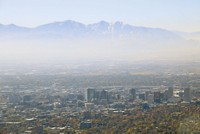Advertisement
Grab your lab coat. Let's get started
Welcome!
Welcome!
Create an account below to get 6 C&EN articles per month, receive newsletters and more - all free.
It seems this is your first time logging in online. Please enter the following information to continue.
As an ACS member you automatically get access to this site. All we need is few more details to create your reading experience.
Not you? Sign in with a different account.
Not you? Sign in with a different account.
ERROR 1
ERROR 1
ERROR 2
ERROR 2
ERROR 2
ERROR 2
ERROR 2
Password and Confirm password must match.
If you have an ACS member number, please enter it here so we can link this account to your membership. (optional)
ERROR 2
ACS values your privacy. By submitting your information, you are gaining access to C&EN and subscribing to our weekly newsletter. We use the information you provide to make your reading experience better, and we will never sell your data to third party members.
Environment
EPA Tightens Standard For Soot Pollution
Air Quality: Critics claim rule could cause economic harm; advocates tout health benefits
by Glenn Hess
June 19, 2012

The Obama Administration has proposed a more stringent air quality standard for particulate matter, or soot, which is intended to reduce harmful emissions from refineries, manufacturing plants, and automobile exhausts.
The proposed rule would set a new annual standard for fine particles—those 2.5 µm in diameter or smaller—in a range between 12 and 13 µg/m3 calculated as a three-year average. The current standard is 15 µg/m3.
Public health advocates and environmental groups applauded the June 15 move by the Environmental Protection Agency, saying it will protect millions of Americans at risk for soot-related lung and heart problems and premature death.
“The science is clear, and overwhelming evidence shows that particle pollution at levels currently labeled as officially ‘safe’ causes heart attacks, strokes, and asthma attacks,” says Albert Rizzo, chairman of the board of the American Lung Association.
But congressional Republicans and business groups called the revised air standard too strict and say it could hurt economic growth and cause job losses in areas of the country that fail to meet the new federal standard.
Rep. Ralph Hall (R-Texas), chairman of the Science, Space & Technology Committee in the House of Representatives, says he is concerned that EPA “is pursuing yet another costly, job-killing regulation.” Hall says he is also troubled that the rule “appears to be based on secret data that EPA has refused to make public.”
Howard Feldman, director of regulatory and scientific affairs for the American Petroleum Institute, the top lobbying group for the oil and gas industry, says EPA’s proposal “could substantially increase costs to states, municipalities, businesses, and ultimately consumers without justified benefits.” In addition, he says, EPA has ignored “important scientific data” while other “purported findings have been misinterpreted.”
The American Chemistry Council, which represents more than 140 large chemical companies, also says “there are many questions surrounding the process by which EPA selected the science studies” that form the basis for the agency’s proposal.
Gina McCarthy, EPA assistant administrator for air and radiation, says the proposed changes are consistent with advice from the agency’s science advisers and are based on extensive research. “It’s clear we have to strengthen the standard for fine particles,” she asserted during a conference call with reporters on June 15.
Mindful of the political risks, the Administration planned to delay the new soot standards until after the November elections. But a federal judge ordered EPA to act after 11 states filed a lawsuit seeking a decision this year. The agency says it plans to seek comment and hold hearings before issuing the final standard by mid-December.
States will have until 2020 to comply, but McCarthy says most will probably not have to take steps to further curb fine particle pollution. “We’re already on the path for 99% of U.S. counties to meet the standard without the need for additional state or local action,” she says.
The Clean Air Act requires EPA to review and consider revising air quality standards every five years. The agency revised the particulate matter standard most recently in 2006.




Join the conversation
Contact the reporter
Submit a Letter to the Editor for publication
Engage with us on Twitter